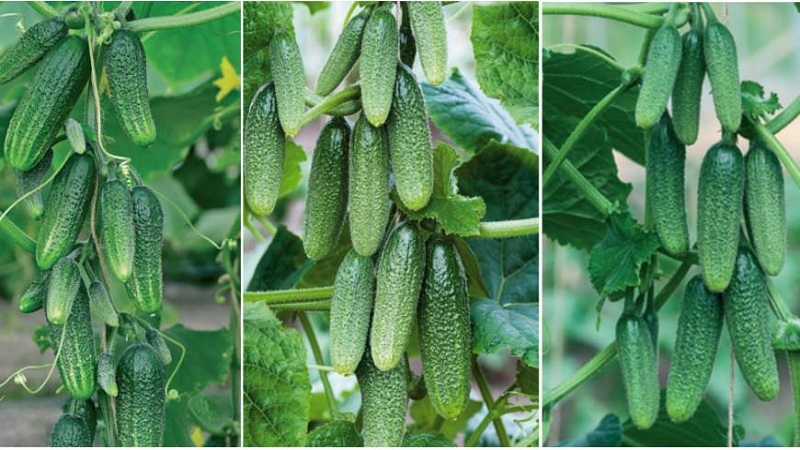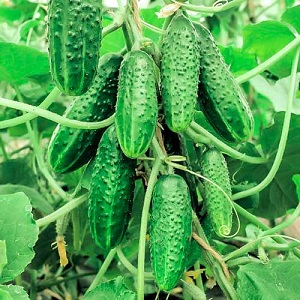Review of the best bunch varieties of cucumbers for open ground
Tufted cucumbers are the merit of European and Russian breeders. New hybrids and varieties were appreciated by summer residents and large farmers, because with relatively low labor costs from 1 m², it is possible to collect from 10 to 40 kg of selected fruits. Cucumbers are unpretentious in care, ripen early, and are immune to major diseases.
In this article, we will talk about the features and advantages of beam crops, we will give examples of popular varieties and hybrids for unprotected soil.
The content of the article
Features of bunch cucumbers
Such crops are characterized by a bouquet form of flowering. In one node, 3–9 fruit ovaries are formed. This is the main difference between bundled vegetables and cucumbers with single or paired ovaries.
The yield of such varieties depends on the degree of branching: the higher it is, the more productive the plants are. For example, about 35 fruits with a total weight of 9-10 kg are harvested from one strongly branched bush. Subject to agricultural technology, up to 500 cucumbers from one plant are harvested per season.
In the photo - bunch cucumbers.

The advantages of such cultures:
- high productivity;
- inflorescences open alternately, ensuring a stable harvest;
- fruits do not outgrow;
- trellis growing saves space on the site;
- cucumbers ripen amicably at the height of the season;
- fruits of the gherkin type;
- plants are resistant to cucumber diseases (cucumber mosaic virus, cladosporium disease, root rot, olive spot, powdery mildew, peronosporosis) and changes in air temperature;
- most hybrids are parthenocarpics (do not need pollination).
Seeds from such fruits are not harvested for reuse - this is the main drawback of the culture.
reference... The largest bouquet ovaries are formed under the trellis and on the most illuminated side shoots.
Bunch cucumbers are photophilous: the more sunlight hits the plants, the higher the yield. Bushes react poorly to drafts. When cultivated in the open air, side-by-side crops (corn, sunflower) are planted to protect against gusty winds.
When caring for the bushes, it is important to maintain an optimal level of soil moisture (do not overflow or leave the soil dry).
During the fruiting period, the need for minerals increases sharply. Therefore, the bushes are fed at least 1 time in 7-10 days with small portions of complex fertilizers (10 g / m²) containing potassium, phosphorus and nitrogen ("Master", "Solution").
Experienced farmers advise picking cucumbers frequently, every 1 to 2 days, to maintain high yields.
Superbeam
Superbeam cucumbers are hybrid plants capable of tying 8–12 fruit ovaries. Vegetables no larger than 6–8 cm are harvested from the bushes - pickles and gherkins. They are ideal for canning.
The stem of the bouquet shoots is short, almost invisible. In the axil of the leaf, only a superbunch with a large number of female flowers can be seen.
The photo shows how superbundled cucumbers look like.

Overview of bunch varieties and hybrids
When choosing seeds of bunch cucumbers, they pay attention to the type of pubescence, the shape and length of the fruits, taste, characteristics of agricultural technology, sowing time, type of plant branching. The result of cultivation depends on this.
Low-branching bushes require minimal maintenance and pinch... Crops are characterized by an early ripening period and a friendly return of fruits in the first months of harvest.
Vigorous plants with powerful branching need regular molding, but they are more resistant to bad weather and diseases, and bear fruit before frost.
The table below summarizes the main characteristics of bunch varieties and hybrids of cucumbers for open ground. All of them are with parthenocarpic type of pollination except for the Alligator - it is bee-pollinated.
| Name | Specifications | Fruit |
| Hummingbird f1
|
Early hybrid (40–45 days). Low-growing bushes with weak branching, form 4-5 ovaries per node. Productivity from 1 m² 11-13 kg. | Fusiform green. The skin has frequent tubercles and white pubescence. Length - 6-8 cm, weight - 60-80 g. |
| Tom Thumb f1 | Ultra early hybrid (37–39 days). Bushes are powerful, highly branched. The number of ovaries is 3–6. Productivity from 1 m² 10-13 kg. | Cylindrical, green. The mounds are large, white-spine. Length - 6-10 cm, weight - 50-65 g. |
| F1 Prestige | Medium early hybrid (43–45 days). Branch type - medium. There are 3-4 ovaries in one node. Productivity from 1 m² 24-25 kg. | Cylindrical, green in color, with large tubercles and white spines. The pulp is firm, without bitterness. Length - 6-8 cm, weight - 70-90 g. |
| Robin Hood f1 | Early hybrid (41–43 days). The bushes are medium-sized with a weak type of branching. 4-5 ovaries are formed in one node. Productivity from 1 m² 6-7 kg. | Cylindrical, length - 4-5 cm, weight - 45-55 g. Green skin with white stripes and small tubercles, black thorn. |
| Beam charm f1 | Early hybrid (40–45 days), medium-branched bushes. There are 3–7 ovaries in the nodes. Productivity from 1 m² is 38–44 kg. | Cylindrical light green with small tubercles. Length - 8-9 cm. Weight - 80-90 g. |
| King of the garden f1 | Mid-season hybrid (45–45 days). Bushes of medium vigor with little branching. In knots of 3-5 ovaries. Productivity from 1 m² 11-12 kg. | Cylindrical emerald green with light stripes. Length - 9–11 cm, weight - 80–90 g. Hillocks are small, pubescence is whitish. |
| Ginga f1 | Mid-season medium-growing hybrid. Harvesting begins 45-50 days after planting. Productivity from 1 m² is 4–7 kg. | Cylindrical, slightly ribbed, emerald green. Length - 9-12 cm, weight - 80-90 g. |
| Alligator f1 | Mid-early medium-growing hybrid (43–54 days). There are 1–3 ovaries in the nodes. Bee-pollinated. Productivity from 1 m² 9–12 kg. | Dark green, unusual elongated cylindrical shape. Length - up to 40 cm, weight - 300-310 g. Small tuberous peel with spiny white thorns. |
| Balcony f1 | An early ripe hybrid (39–42 days). Bushes with a medium type of branching. In the nodes, 3–6 ovaries are formed. Productivity from 1 m² 10-11 kg. | Cylindrical, green. The tubercles are small, whitish. Length - 8-9 cm, weight - 90-95 g. |
| Blizzard f1 | Ultra early hybrid (40–43 days). The bushes are medium-sized with weak branching. In knots of 4-5 ovaries. Productivity from 1 m² 15-16 kg. | Cylindrical, dark green. The skin is dense, large tuberous with white pubescence. Fruits are short, 6–8 cm long, weight 72–78 g. |
| Detinets f1 | Early hybrid (40–45 days). Bushes of medium height, medium branched. There are 4-5 ovaries in the knot. Productivity from 1 m² 14-15 kg. | Cylindrical, green with short stripes. Length - 10-11 cm, weight - 90-130 g. |
| F1 champion | Mid-season hybrid (50–55 days). Bushes are compact, medium-branched. The number of ovaries is 2–4. Productivity from 1 m² 23-25 kg. | Cylindrical, aligned, green in color with large tubercles and white spines. Length - 8-10 cm, weight - 80-90 g. |
| Avalanche f1 | Early hybrid (38–42 days). The bushes are medium-sized with a medium type of branching. The number of ovaries is 4-5. Productivity from 1 m² 15-16 kg. | Green in color, cylindrical black spikes. Length - 7-8 cm, weight - 60-70 g. |
| Lisette f1 | Early hybrid (38–42 days). The bushes are powerful, medium-sized, medium-growing. There are 3–8 ovaries in the nodes. Productivity from 1 m² is 8–11 kg. | Cylindrical with a white edge and frequent tubercles. Length - 6-8 cm, weight - 90-100 g. |
| Dwarf f1 | Early hybrid (40–45 days). Strongly branched bushes. 3-4 ovaries are formed in the sinus. Productivity from 1 m² 9-10 kg. | Cylindrical, dark green, medium tuberous, with a white edge. Length - 6-8 cm, weight - 80-90 g. |
| Chistye prudy f1 | An early ripe hybrid (39–42 days) with medium vigor and branching. The number of ovaries is 3–7. Productivity from 1 m² 9-13 kg. | Oval green with short stripes. The tubercles are medium, the pubescence is white. Length - 10-12 cm, weight - 110-120 g. |
| Ant f1 | Early ripe hybrid (37-38 days). Bushes are medium-sized, weakly branched. The number of ovaries is 3–6.Productivity from 1 m² 10-12 kg. | Oval, green in color, with mid-length stripes. The mounds are large, the edge is white. Length - 8-11 cm, weight - 100-110 g. |
| Swallowtail f1 | Early hybrid (38–40 days). Bushes are undersized with weak branching. The number of ovaries in one node is 4-5. Productivity from 1 m² 13-14 kg. | Fusiform, short, green. The tubercles are medium, the edge is white. Length - 6-9 cm, weight - 60-110 g. |
Reviews
Bunch and super bunch cucumbers are popular with summer residents due to their early ripening, excellent fruit taste and easy care.
Valentina, Voronezh: “I have been cultivating cucumbers for over 10 years. I plant mainly parthenocarpics with bundle fruiting in the open field. One of the best hybrids for me is the Little Boy. In the summer I live in the country and take off the harvest every other day. There are always a lot of cucumbers, the size is one to one. Fruits are fragrant crispy, not bitter. Care is simple: drip watering, feeding mineral compounds, molding with a garter to the trellis. "
Vladislav, Oryol: “I grow bunch cucumbers both in the greenhouse and in the garden. I come to the dacha for the weekend. I harvest in buckets. My favorites are Blizzard and King of the Garden. I installed a drip irrigation system on the site. I fertilize with complex liquid mineral preparations ”.
Conclusion
Bunch varieties and hybrids of cucumbers are a real find for those who do not have the opportunity to plant plantations on their personal plot. In one node, from 3 to 12 ovaries are formed. Cucumbers ripen at the same time, most of the harvest is given in the first 2 months. Productivity depends on the branchiness of the plant. 30-35 fruits are collected from one bush.
Tufted and super-tufted cucumbers are predominantly parthenocarpic type of pollination. The fruits do not taste bitter, do not outgrow, retain freshness for a long time, are suitable for fresh consumption and canning.
